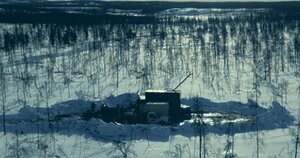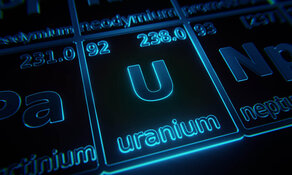The Energy Report: Jeb, in past interviews you have talked about the boost that the end of the Russian nuclear material purchase agreement would have on uranium prices. But lately, the price has dropped. What is causing the most recent decline?
Jeb Handwerger: The end of the Russian highly-enriched uranium (HEU) agreement did, indeed, kick off a strong Q1/14 for uranium prices. Many juniors had phenomenal returns. Some doubled, some tripled during those months. But since March, we've hit new lows in the uranium price, and many of the gains made in the Q1/14 rally have been given back. Some prices have even hit below the 2013 lows.
The uranium spot price has been in a seven-year downtrend. When you get to a bottom, you sometimes have false starts, and you bounce along. That's exactly what we're dealing with in 2014. Market sentiment is still extremely negative, but the smart, long-term investors who look at the supply/demand fundamentals over a three- to seven-year horizon have a different perspective than short-term traders looking for a quick turnaround profit. We think this is an excellent time for fundamental investors to get into the space. The longer the base, the more time investors have to acquire positions in the high-quality junior uranium miners that are literally trading for pennies.

The real concern is Japan. Many expected Japan to restart nuclear reactors faster than it has. Even though Japan has released an energy plan with nuclear as a major cornerstone, it takes time for nuclear reactors to restart. That leaves Japan, its businesses and its citizens paying ridiculously high electricity costs for imported natural gas.
TER: Have you seen any signs that Germany might restart production?
JH: The key is the battle of wills going on in Eastern Europe right now. When German Chancellor Angela Merkel had a knee-jerk reaction after the Fukushima reactor disaster, deciding to rely on renewables rather than nuclear energy, what she really did was make the large German economy dependent on nuclear power from France and natural gas from Russia, through Ukraine. The result is skyrocketing electricity costs and increased political risk.
Now we have had the wake-up call I have been warning about from Russia. President Vladimir Putin has Western Europe in a very vulnerable situation if he decides to turn off the taps. This may force a change in sentiment in Germany, which may want to rethink nuclear. It's becoming a real energy security crisis there.
TER: In a past interview with The Mining Report, you said that China is on a commodity buying spree. Can China's nuclear construction pull the uranium sector up without Japan and Germany?
JH: Over the long term, yes. Currently, China uses only a fraction of what the developed countries in Europe and the U.S. use. That's going to change over the next generation. The Chinese can no longer rely on dirty coal. Coal has created environmental havoc in major cities, where it is becoming difficult to breathe.
"Enterprise Group Inc. has an attractive balance sheet and the ability to grow."
Nuclear is going to be extremely important for the Chinese over the next generation. That is where the major growth is going to be. China National Nuclear Power Co. recently announced plans to raise up to 16.25 billion yuan ($2.6 billion) in an initial public offering to fund nuclear-power projects. That's significant news. It tells me the Chinese are willing to invest because they realize the critical nature of clean energy, of being able to provide enough energy without compromising air quality. Long-term contrarian uranium investors still see nuclear as the key clean baseload power source because renewables are not able to make that gap.
A recent documentary called "Pandora's Promise" showed former anti-nuclear environmentalists speaking out for atomic energy because they have realized it is the only practical way to reduce fossil fuel consumption and, thus, carbon emissions. Remember, nuclear reactors today do not use the same technology as 20, 30 or 40 years ago. New nuclear will utilize small, modular reactors that are safer, more efficient and more adaptable than massive, expensive, meganuclear plants.
TER: Is the U.S. getting serious about the need for domestic sources for the uranium to feed these modular reactors?
JH: Yes. The U.S. is the largest consumer of nuclear power. It uses about 55 million pounds (55 Mlb) of uranium per year, but only about 4 Mlb are produced domestically. That has to change. It will change over the next generation, because we can't rely on the cheap, secondary supplies that Russia gave us for close to 20 years.
Now that that cheap resource is not available, the U.S. will have to turn to domestic uranium producers, such as Cameco Corp. (CCO:TSX; CCJ:NYSE), operating in the Powder River basin in Wyoming. For the first time in over 30 years, new nuclear reactors are being built in the U.S. Many of the older reactors will have to be replaced with newer reactors. There is going to be a need for new domestic uranium producers that can produce at a low cost.
The companies outperforming in the uranium mining space that have not hit new lows have been the lower-cost producers, the in situ miners in the U.S., such as Ur-Energy Inc. (URE:TSX; URG:NYSE.MKT) and Uranerz Energy Corp. (URZ:TSX; URZ:NYSE.MKT). The explorers and the current higher-cost producers have been hit hard because the uranium spot has come back down.
Uranerz already has secured long-term offtake arrangements with some of the largest U.S. utilities. It is just coming into production, and is planning a third production center that will add more feed to the Nichols Ranch project. Management was smart enough to secure a long-term offtake arrangement with utilities at much higher prices.
Many of the uranium producers selling into the spot price will be under price pressure. However, new producers with attractive long-term agreements have time. The short term looks ugly, but the long term looks exceptionally exciting. This appears to be the time for contrarian value investors to continue to accumulate. It's why we're seeing big money, such as Uranium Participation Corp. (U:TSX), raising $58 million ($58M) to buy spot uranium. When Uranium Participation Corp. and other investors in the uranium sector begin buying again, we could once again see uranium miner stock prices double and triple, even if the uranium spot price moves just a few dollars.
TER: Uranerz actually started the year off pretty strong. Does it still have catalysts lined up for the rest of this year?
JH: The company announced in the middle of June that it sent its first resin shipment to Cameco's Smith Ranch facility for final processing into uranium concentrate. This is very significant. The next step is making its first delivery of uranium to the conversion facility, where the customers will take ownership of the product. Uranerz stock hit a low in 2013 at around $0.85/share. It is trading currently around $1.50/share, from a high of about $1.90/share. In a space where many companies have come back to their lows, Uranerz is maintaining its uptrend, because it is one of the few uranium miners actually performing.

TER: Rick Rule has called uranium the most hated commodity, and one of the best buying opportunities. What do you tell people who are looking for the courage to be contrarian when everyone else is running the other way?
JH: Right now, being a uranium investor is extremely difficult. The spot price continues to hit lows. No one wants to touch it. There's an old saying that to be rich in the market you have to buy straw hats in the winter and winter coats in the summer. There's no doubt about it, the spot price has taken a nasty tumble. But this may be the shakeout that allows long-term value investors to accumulate uranium miners at exceptionally low prices. There is major capital on the sidelines. There is going to be a supply shortfall, and the uranium price is going to rally. But it takes patience and courage to look at a sector when no one else is willing to pay attention to it.
What we saw earlier this year, when some uranium miners doubled and tripled, is just the beginning. There are going to be false starts as we come off the bottom and bounce along. This is where the timid give up. Every time the price bounces and drops back, investors lose hope and get discouraged. The real winners in this game are the investors who are able to withstand the volatility.
We're just beginning to see base metals and commodities turning the corner from the financial crisis of 2008. The overall economy is just beginning to show signs of improvement. That's going to be good for energy and commodities. Sometimes, you have to look for the commodities that have been beaten down and are trading at decade lows, but are growing increasingly in demand. There is no doubt that uranium fits that bill.
TER: One thing people do seem to be excited about is oil and gas, particularly fracking. We recently ran an interview with T. Boone Pickens where he talked about leveraging the oil and gas renaissance for profit and national security. What is your favorite way to get exposure to the shale plays?
JH: Oil is beginning to break out. We saw it break out higher, above $105/ barrel ($105/bbl). It may eventually make a major breakout past $110/bbl. Geopolitical tensions in Iraq could send oil prices skyrocketing. That's why we've seen this huge boom in shale in North America, including, most recently, in western Canada, where numerous liquefied natural gas (LNG) projects and pipelines are being planned.
Big money is coming into the energy space, because these pipelines and terminals will be able to supply Asia with cheaper oil and gas. Asian countries currently pay quadruple what North Americans pay. These infrastructure projects, such as pipelines and LNG terminals, are just beginning to be built, and western Canada could be a key area of great growth.
One of our favorite companies that could benefit from this trend is Enterprise Group Inc. (E:TSX.V), which is a one-stop shop for the major oil exploration and production companies. It has contracts with some of the big boys, including Royal Dutch Shell Plc (RDS.A:NYSE; RDS.B:NYSE) and Encana Corp. (ECA:TSX; ECA:NYSE), and it is getting major capital. Enterprise was able to raise $27M to invest in the sector. Big money is interested in the oil and gas services business. Enterprise has an attractive balance sheet and the ability to grow. The company announced Q1/14 revenue of $21M, more than double last year's $9M. Enterprise also recently announced its largest contract ever: $19M with Canada's largest natural gas producer. A small-cap oil field service company with a market cap below $150M and contracts with large players planning to spend billions of dollars on drilling over the next decade is really a unique situation.
TER: Are oil services a less risky way to invest in the sector?
JH: Yes, because these companies have contracts with some of the largest companies with long-term exploration plans. The opportunity really is in the infrastructure. One of the least risky ways to make money is providing the services to the explorers and the producers. That's what Enterprise is doing.
TER: The other thing that investors seem to be excited about is the prospect of a gigafactory for battery development. What is the best way to get exposure to the battery market? Graphite? Lithium?
JH: I have long been excited about the potential growth in the battery market for electric vehicles, grid storage and mobile electronics. Mobile phones, smartphones and laptop computers are a part of everyday life. The same is true with electric vehicles. Tesla Motors Inc. (TSLA:NASDAQ) is a huge market cap company with some very significant plans, including construction of the biggest lithium-ion (Li-ion) battery plant right here in the U.S.
Demand in the Li-ion battery market is set to grow rapidly over the next seven years. This could be a game-changer for some North American lithium and graphite miners. Battery manufacturing could be a major area of economic growth for the U.S., especially the southwestern U.S., over the coming decades. This could have the same impact as the internal combustion engine, revolutionizing transportation. President Barack Obama is pushing to reduce carbon emissions. Tesla may be in the market for lithium and graphite deposits in North America that could supply its manufacturing plants. Most of current lithium supply either comes from Chile, Argentina or Australia. A North American lithium asset could be very profitable.
TER: What are some possible companies that fit that description?
JH: One that we've followed for years is Western Lithium USA Corp. (WLC:TSX; WLCDF:OTCQX). The company's location in Nevada, with one of the most advanced lithium deposits, is very compelling for battery makers. In addition, Western Lithium is going to be in production shortly, producing hectorite clays used in the fracking industry for deep directional drilling. It is fully permitted for its Hectatone organoclay business, and has raised over $9M. The Hectatone business is looking good for startup in the fall; plans should be complete in the summer. The lithium demonstration plant is scheduled for launch in Germany at the end of 2014. Western Lithium has two tracks—the Hectatone business for the oil and gas industry, and lithium for Tesla. Both tracks are moving forward, and in exciting areas.
TER: It looks like the market has recognized that. The stock price had a nice little spike earlier this year.
JH: I think it's just the beginning.
TER: Any final words of wisdom for our readers?
JH: There are still opportunities in the energy market. It's important to focus on the market cycles, and not follow what everyone else does. People think markets go up forever, but bear markets occur and, overnight, can wipe out investment gains that took months or even years to build. In the same way, bear markets can go down for a while but, all of a sudden, things could change. It is important to understand the cyclical nature of the commodity markets, and to be able to accumulate when no one else is buying and sell when people are willing to buy at ridiculous valuations. This is part of mastering your emotions. You have to continue looking at companies with strong fundamentals.
Jeb Handwerger is an author, speaker and founder of Gold Stock Trades. He studied engineering and mathematics at University of Buffalo and earned a master's degree at Nova Southeastern University. After teaching technical analysis to professionals in South Florida for over seven years, Handwerger began a daily newsletter, which grew to include thousands of readers from over 40 nations.
Read what other experts are saying about:
Want to read more Energy Report interviews like this? Sign up for our free e-newsletter, and you'll learn when new articles have been published. To see recent interviews with industry analysts and commentators, visit our Streetwise Interviews page.
DISCLOSURE:
1) JT Long conducted this interview for Streetwise Reports LLC, publisher of The Gold Report, The Energy Report, The Life Sciences Report and The Mining Report, and provides services to Streetwise Reports as an employee. She owns, or her family owns, shares of the following companies mentioned in this interview: None.
2) The following companies mentioned in the interview are sponsors of Streetwise Reports: Enterprise Group Inc., Uranerz Energy Corp., Royal Dutch Shell plc. Streetwise Reports does not accept stock in exchange for its services.
3) Jeb Handwerger: I own, or my family owns, shares of the following companies mentioned in this interview: Uranerz Energy Corp., Enterprise Group Inc., Ur-Energy Inc., Western Lithium USA Corp. I personally am, or my family is, paid by the following companies mentioned in this interview: None. My company has a financial relationship with the following companies mentioned in this interview: Uranerz Energy Corp., Enterprise Group Inc., Western Lithium USA Corp. I was not paid by Streetwise Reports for participating in this interview. Comments and opinions expressed are my own comments and opinions. I had the opportunity to review the interview for accuracy as of the date of the interview and am responsible for the content of the interview.
4) Interviews are edited for clarity. Streetwise Reports does not make editorial comments or change experts' statements without their consent.
5) The interview does not constitute investment advice. Each reader is encouraged to consult with his or her individual financial professional and any action a reader takes as a result of information presented here is his or her own responsibility. By opening this page, each reader accepts and agrees to Streetwise Reports' terms of use and full legal disclaimer.
6) From time to time, Streetwise Reports LLC and its directors, officers, employees or members of their families, as well as persons interviewed for articles and interviews on the site, may have a long or short position in securities mentioned. Directors, officers, employees or members of their families are prohibited from making purchases and/or sales of those securities in the open market or otherwise during the up-to-four-week interval from the time of the interview until after it publishes.







































